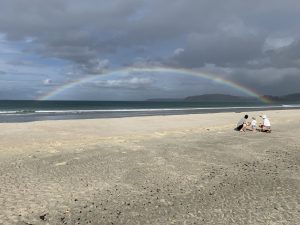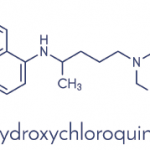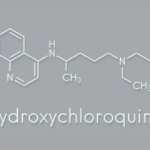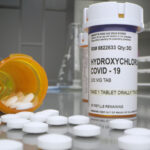Editor’s note: We are sad to announce that we have learned of the passing of Dr. Philip C. Robinson. We will share more as it becomes available, but in the meantime, we wanted to repost this article he wrote for The Rheumatologist early in the pandemic. Dr. Robinson also took the photo of the full-arc rainbow below. The Australian Rheumatology Association has created a form for those who would like to send condolences to the family.
On March 11, the World Health Organization declared COVID-19 a pandemic. I was on holiday, standing on an idyllic, windswept beach in northern New Zealand, but I couldn’t focus on the rainbow. I had a pandemic on my mind. There were growing dark clouds in the world.
I was closely following the development of the pandemic on Twitter, the beloved social media choice of celebrities and world leaders. I was trying to gauge the scale of the problem and how it would affect me and my professional life as a rheumatologist.
Leonard H. Calabrese, DO, FACR, a rheumatologist from the Cleveland Clinic (@LCalabreseDO) tweeted about an effort by inflammatory bowel disease (IBD) doctors to establish a registry (SECURE-IBD) to capture information about outcomes of IBD patients affected by COVID-19. This led to a Twitter discussion among a group of rheumatologists about what a great initiative this was and whether anyone in rheumatology was doing this. One Zoom conference later, with Jinoos Yazdany, MD, MPH, from the University of California, San Francisco (UCSF, @JYazdanyMD) and her research group, and we had a small but growing team investigating how we could put a registry together.
Information Gap
Information about how rheumatic disease patients fared when they were infected with COVID-19 was absent. Previous coronavirus epidemics causing the severe acute respiratory syndrome-1 (SARS-1) and Middle East respiratory syndrome (MERS) had yielded scant information on outcomes in rheumatic disease patients. It was clear to those who were following the reports that this was going to be worse than any previous coronavirus epidemic. Our patients would be infected, and in all likelihood, some would die.
Many of the medications rheumatic disease patients commonly take have been shown in countless clinical trials to lead to an increased risk for serious infection. But discussions about how these same medications could be helpful to protect against the severe cytokine storm manifestations of COVID-19 were also taking place.
The urgency to address the information deficit was clear, and the enthusiasm to get it done was palpable. By March 15, three days after the discussions first started, 137 people were registered on an email list; the following day the Twitter feed for the effort (@rheum_covid) had 863 followers and was growing quickly. Teams were established to address required institutional review board applications, investigate and build the registry infrastructure and design the case collection form.
Other teams were asking the question, “What does the currently available literature tell us about the effect of the drugs we use in rheumatology on infection risk and outcome?” At that stage no one could have envisioned the political furor that would be in full swing less than a month later regarding hydroxychloroquine (HCQ), but more on that later.
The effort was named the COVID-19 Global Rheumatology Alliance to reflect worldwide collaboration.
There is a significant benefit in trying to collect all cases in one registry to improve power, and the way to do that was for it to be a global effort. The Alliance’s goal is to collect information in a streamlined way, analyze it quickly and disseminate it so people can make decisions with the best available information.
We were also mindful that the registry would only ever be a de-identified case series of patients, with no denominator and no control group. So the conclusions that could be drawn from the collected data would be limited. However, stories emerged of patients on biologics and methotrexate being infected and remaining well. This extremely useful information has already demonstrated the value of the registry. Cases like that were immediately able to provide some reassurance that not all patients in this scenario would become unwell and require hospitalization or advanced medical intervention.
There is a significant benefit in trying to collect all cases in one registry to improve power, & the way to do that was for it to be a global effort.
Efforts Grow
The effort expanded, and a website was established. Leads in information technology, administration, organizational liaison and media, literature review, the European region and registry development were appointed, and a steering committee was formed. Patients were invited onto the steering committee to provide the essential patient voice.
The idea of a patient-reported registry was explored to capture information from patients about their experiences with the pandemic. This was an important component of the Alliance’s effort. The concern was that mild or asymptomatic cases would not be reported with the same frequency as those requiring hospital admission, because they simply wouldn’t come to the attention of a rheumatologist or someone who knew of the registry.
A Slack channel, which is a multichannel online workspace, was established. Numbers on the Slack channel grew to more than 400, with patients, rheumatologists, fellows and scientists all contributing to the discussion, which ranged from COVID-19 epidemiology to treatment protocols and discussions about potential therapeutics.
Many organizations pledged their commitment to the effort, and the website was quickly populated with the names of professional societies, patient organizations, academic journals, research organizations and medical practices that supported the effort.1 At present count, the supporters number 288.
Going Live
The global registry went live on Tuesday, March 24, 12 days after it was conceived. Due to the requirements of the European General Data Protection Regulation, a separate mirror registry run by the European League Against Rheumatism (EULAR) had to be formed. It reports its cases consolidated with the Global Alliance Registry cases. This partnership between the Alliance and EULAR demonstrated the collegial and collaborative way that all involved had pulled together to face this challenge.
The Global Alliance survey is hosted by UCSF, and the EULAR registry is hosted by the University of Manchester, U.K. The registries are collecting de-identified demographics, details of the underlying rheumatic disease, rheumatic disease treatments, COVID-19 diagnosis details, COVID-19 treatments and outcomes. The form is designed to take 5–10 minutes to complete, and case outcomes can be added at a later date if they are not known at the time the case is first entered into the registry.
During the pandemic, we have seen an explosion of academic publications on COVID-19, both peer reviewed and uploaded to preprint servers. The Alliance was determined to leverage the efforts of other doctors and scientists to both identify what we know about rheumatology patients, rheumatology drugs and COVID-19, and also identify the gaps in knowledge . This would be the first step in thinking about how these gaps in knowledge could be addressed. To this end, Alliance teams are conducting systematic reviews into important COVID-19 related topics.
A patient experience survey was added to collect the experiences of patients during the pandemic, both those who were infected and those who were not. Patients have made a huge contribution to the Alliance, providing the patient voice to all activities, being an integral part of the steering committee and making vital contributions to work we are undertaking.
Members of the Alliance have been the driving force of its achievements, and they have contributed from all over the globe. For example, the patient survey was quickly translated into numerous languages by multilingual Alliance members to enable greater reach. The patient experience survey is now available in six languages.
ACR Involvement
The Alliance received offers for both financial and in-kind support, and it became clear that we needed a more formal structure to manage this process. We discussed with the ACR the support it could offer. The Alliance decided to accept the ACR’s offer and recently become a section of the College. This has enabled us to continue to concentrate on the work we felt was the most important—collecting, analyzing and disseminating case information—while others with the skills and knowledge to do so concentrated on logistical and financial issues.
From the start there was, and continues to be, an understanding that this arrangement is to enable the Alliance to concentrate on the core work. In time, the steering committee plans to create an independent organization to serve the global rheumatology community.
Tangible Results
A tangible example of the contribution we have been able to make has come from the data we have been able to provide with respect to HCQ and COVID-19. Intense discussion on social media, traditional media and among officials concentrated on whether HCQ could be useful in treating COVID-19.
Although some claimed those on HCQ couldn’t get COVID-19, we were able to contribute data to this discussion, pointing out that we had received numerous reports of patients taking HCQ who had become infected with COVID-19. This critical information helped inform discussions, and members of the Alliance also contributed invited pieces to academic journals on this topic, as well as what effect the interest in HCQ was having on our patients who still needed to take it for their rheumatic disease.2,3
Thanks goes to all participating rheumatologists, research staff and patients, members of the Alliance, the Alliance steering committee and subcommittees, and our supporters, especially EULAR and the ACR. Without the support and enthusiasm of all involved, this effort would not have proceeded.
We aim to provide the global rheumatology community with accurate, reliable information upon which to make decisions. As I am writing this, 573 cases are in the global and European registries, combined, and more than 9,500 patients have responded to the COVID-19 patient survey.
The full breadth of the rheumatology community has expressed interest in this effort to fill an information void that endangers our patients. Nothing short of an amazing collaborative effort by an absolutely huge number of people has brought this project to fruition. I think the rheumatology community can be immensely proud of this tangible demonstration of passion and drive to pull together in the face of a global crisis.
Philip C. Robinson, MBChB, PhD, FRACP, is associate professor at the faculty of medicine, University of Queensland and senior staff specialist in rheumatology at the Royal Brisbane Hospital, both in Brisbane, Australia. He is the chair of the steering committee for the COVID-19 Global Rheumatology Alliance. Follow him on Twitter: @philipcrobinson.
Disclosures
Dr. Robinson declares no competing interests related to this work, but has received personal consulting and/or speaking fees from AbbVie, Eli Lilly, Janssen, Novartis, Pfizer and UCB, as well as non-financial support from Roche.
Acknowledgments
Dr. Robinson would like to acknowledge the assistance of Jinoos Yazdany and Pedro Machado in providing comments on this article in development.
References
- Robinson PC, Yazdany J. The COVID-19 Global Rheumatology Alliance: Collecting data in a pandemic. Nat Rev Rheumatol. 2020 Apr 2.
- Kim AHJ, Sparks JA, Liew JW, et al; COVID-19 Global Rheumatology Alliance. A rush to judgment? Rapid reporting and dissemination of results and its consequences regarding the use of hydroxychloroquine for COVID-19. Ann Intern Med. 30 Mar 2020. [Epub ahead of print]. doi:10.7326/M20-1223
- Yazdany J, Kim AH. Use of hydroxychloroquine and chloroquine during the COVID-19 pandemic: What every clinician should know. Ann Intern Med. 2020. [Epub ahead of print 31 March 2020].




